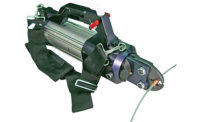To the general public, the term handheld is synonymous with mobility. But, to assemblers of wire harnesses, the term also refers to tools that offer simplicity, reliability and accuracy.
“When it comes to hand tools for crimping wire, companies are most concerned with durability and ergonomics,” says Maria Haynes, product marketing lead specialist at Phoenix Contact. “Budget is also a factor. Companies know that good tools cost more but are worth it. These tools offer the assurance of high-quality crimps in wires used in all types of harnesses, equipment panels and control cabinets.”
In 2015, a large Texas-based electronics contract manufacturer turned to Phoenix Contact for a better way to crimp ferrules onto 16 AWG wire. The hand tools the manufacturer had been using required each assembler to crimp the ferrule once, turn the wire 90 degrees and then crimp the ferrule a second time.
Haynes says she recommended the company try Phoenix’s Crimpfox 6SF hand tool instead. The ratchet-type tool has an integrated lock that remains in place until the necessary crimping pressure is reached, thereby eliminating the possibility of applying too little pressure.
Assemblers at the manufacturer now crimp the ferrule with one tool squeeze and are much more productive. In addition, the crimp causes no connector or terminal damage, and it meets all connector-supplier specifications.
Success stories like this one are why handheld crimping tools remain a necessity to so many wire harness assemblers. These tools enable them to accurately crimp small to medium wire in projects ranging from prototyping and repair, to limited production runs. Most handheld crimping tools used by assemblers are manual, but pneumatic and battery powered models are also available for applications that require many crimps, or involve larger cables or connectors.
A Century (Plus) of Progress
“Terminal suppliers were the first to develop handheld manual tools, and they did this so end-users could properly crimp the terminals onto wire,” notes Tom Andrasek, director of sales and marketing at Pressmaster Inc. “Thomas and Betts did this shortly after designing their first connectors back in the 1890s.”
Although this practice continued for several decades, manual soldering and wire wrapping were the main methods of terminating wire before WWII. But, that would drastically change over the next 20 years.
“The first multi-pin connectors were terminated by soldering the conductor to non-removable contacts,” explains Dave Kelly, a 45-year veteran of the industry and the standards and industry liaison at Daniels Manufacturing Corp. (DMC). “However, high-temperature applications and the need for simple and reliable field service led to the introduction of connectors with removable contacts in the 1940s. These were crimped onto the conductor rather than being soldered.”
By the mid-1960s, various equipment suppliers began offering handheld manual and pneumatic tools with interchangeable dies that crimp different types of connectors. Battery-powered handheld tools appeared in the 1990s.
Manual Rules
Manufacturers need to carefully consider several factors to select the best handheld manual tool for a crimping application. The tool’s ergonomic design and mechanical capabilities are good places to start.
Key ergonomic elements include tool height, grip size, jaw opening angle, internal linkage design, load distribution and leverage during crimping. The shape of the tool is also critical, as tapered heads generally fit better into tight spaces than boxy heads.
Despite being marketed as “universal,” hand tools can vary greatly in size and jaw opening, and, therefore, crimp results. The ideal jaw opening allows easy installation of the connector into the crimp nest (i.e., the part of the die that supports or reshapes the connector during crimping).
On the mechanical side, buyers need to focus first on the tool’s mechanical gain, which is the ratio of applied force at the point of work to the applied force on the handle. The tool’s mechanical gain rating should always be appropriate for the application at hand.
Also important is the tool’s crimping action. Some tools look and operate like pliers, while others look similar but feature an internal ratchet that only releases the connector when the optimum compression is obtained and the crimping cycle is complete.
Both types of tools may be dieless or come with dies and positioners to accommodate different wire sizes, connectors, crimp configurations and shapes. Pliers-style tools are typically used in applications requiring 25 or so connections per shift, whereas ratchet-style tools are preferred for applications requiring 100 or so connections per shift.
Ratchet-style tools ensure consistently accurate crimping, as well as high mechanical and electrical performance of the connector.
The ratchet makes either a scissors or parallel action within the tool. Tools with a scissors-action ratchet are smaller, lighter and offer a higher mechanical gain, but produce a nonsymmetrical crimp. Parallel-action tools are great for open-barrel connectors because they ensure a symmetrical crimp.
“Today’s manual handheld crimpers accommodate more wire sizes, connectors and crimp profiles than ever,” says Haynes. “The tools come in several sizes and handle styles, and allow for front and side crimping of wire typically from 30 to 6 AWG. Portability is another plus, both in the workstation and out in the field.”
In 2016, Phoenix Contact introduced the Crimpfox 4in1 tool that manually cuts, strips, twists and crimps ferrules onto 20 to 14 AWG wire. Strips of ferrules are held in a clear cover magazine in the handle for easy identification. A four-stage pressure lock ensures high-quality crimps.
The company’s four-model Centrus line (two hex and two square crimp profiles) came out in 2017 and features a ratcheted ergonomic handle. Last year, the pliers-style Duo tool hit the market. It crimps single and twin ferrules, and features a rotating die for front or side entry.
Andrasek says that a good manual tool is one that produces a quality crimp when the worker can easily close the handle without having to apply excessive force. This is crucial, because many users of handheld manual crimpers are women, and ergonomic research shows that they typically apply only 20 pounds of force on the tool handle. Men, in contrast, generate 50 pounds.
“Although 20 pounds isn’t excessive, a tool with a high-enough mechanical gain can multiply this force amount to consistently produce a good crimp,” explains Andrasek. “Pressmaster’s first C-Frame tool in 1976 had a mechanical gain of 23-to-1. By the 1990s, we’d increased the gain to 40-to-1, and today it’s 50-to-1. This means only 20 pounds of handle force are needed to produce 1,000 pounds of crimping force.”
For many years, harness assemblers have used long- and short-handle K-Frame manual crimpers from Pressmaster. The long version measures 10.08 inches, weighs 1.15 pounds (frame only) and produces a maximum handle force of 54 pounds. The short version measures 8.03 inches, weighs 1.01 pounds (frame only) and produces a handle force of 70 pounds. Both models produce a maximum crimp force of 2,250 pounds.
Standard features include a scissor-action ratchet, and through-hardened alloy steel construction. The versatile tools have a wear life of 50,000 cycles plus, can be quickly calibrated and are easy to customize for right- or left-handed users. A nonslip pad holds them in place when leveraged on a work surface.
Manual crimping tools from AutomationDirect are economical, easy to use and allow for quick change out of dies and positioners. The company offers four series that include nine models designed to crimp ferrules, ring terminals and other connectors onto 26 to 2 AWG wire. Current customers include OEMs, small shops and integrators that build custom control panels.
Jim Krebs, technical marketer at AutomationDirect, says the DN-FE series is unique because all three models self-adjust to crimp 26 to 8 AWG wire. Each model comes with a different die: square, hexagonal and trapezoidal (rotatable).
Nine dies can be used with the company’s DN-CT crimp tool handle. Krebs says this tool is especially effective at crimping RJ-45 and RJ-12 connectors for Ethernet cable.
Three of the four models in the Z+F series are designed to crimp single and twin ferrules, and offer five, four and two crimping positions, respectively. The other model crimps PVC-insulated terminals onto 20 to 2 AWG wire, and has three crimping positions.
Another manual tool from AutomationDirect is the Knipex pliers. It is 9.25 inches long and crimps insulated and noninsulated terminals and connectors onto 23 to 5 AWG wire.
Two Times the Power
Suppliers recommend the use of a pneumatic or battery powered handheld tool when an application requires the worker to complete hundreds of crimps per shift. Powered tools may or may not use dies and positioners, but unlike manual tools, they operate with the flip of a switch or the press of a trigger, instead of hand force.
Pneumatic and battery powered tools increase throughput and production flexibility—by how much depends on the application and operator experience.
Air-powered crimpers are tethered to an air supply and, depending on model, can produce up to 600 terminations per hour. Haynes says the downside to this tethering is limited mobility, and adds that pneumatic crimping tools often work with fewer types of connectors than manual tools.
Phoenix Contact’s pneumatic Zap series includes three models that trapezoidally crimp ferrules onto 24 to 8 AWG wire. The ferrules meet DIN 46228-1:1992-08 and DIN 46228-4:1990-09 standards, and are laterally crimped in the tools. Wire range for each tool is 24 to 16 AWG (model 25), 24 to 12 AWG (40) and 16 to 8 AWG (100).
DMC’s handheld WA22LC-X1 pneumatic indent crimper is lightweight, ergonomically designed and capable of crimping size 20 and smaller contacts onto 32 to 20 AWG wire. Kelly says the tool is widely used in both military and proprietary applications.
Accurate calibration is maintained by an eight-step machined steel block that holds gauging tolerances longer than the standard adjustment screw. This results in high output with less downtime. The tool’s trigger allows for easy use by right- or left-handed operators.
“Battery powered and other handheld crimping tools are great for those who assemble aerospace wire harnesses on form boards with routing and mounting accessories in place,” says Kelly. “Usually, the first end of each wire is terminated with a manual benchtop crimper or automated machine, and the second end is terminated with a handheld crimper before the wire is installed into the connector.”
The EMC3300 is a lithium-ion battery powered crimper from DMC that terminates many types of connectors onto different sizes of wire and coaxial cable. A spring-loaded side handle opens the tool jaws for die, connector and wire insertion, then closes the jaws to perform crimping. This design optimizes worker productivity, while also eliminating the chance of pinched fingers.
Crimp cycle time is 1.3 seconds, and the tool provides 250 crimps per charge (40 minutes). It features a built-in LED light and stores crimping data that is easily retrievable.






